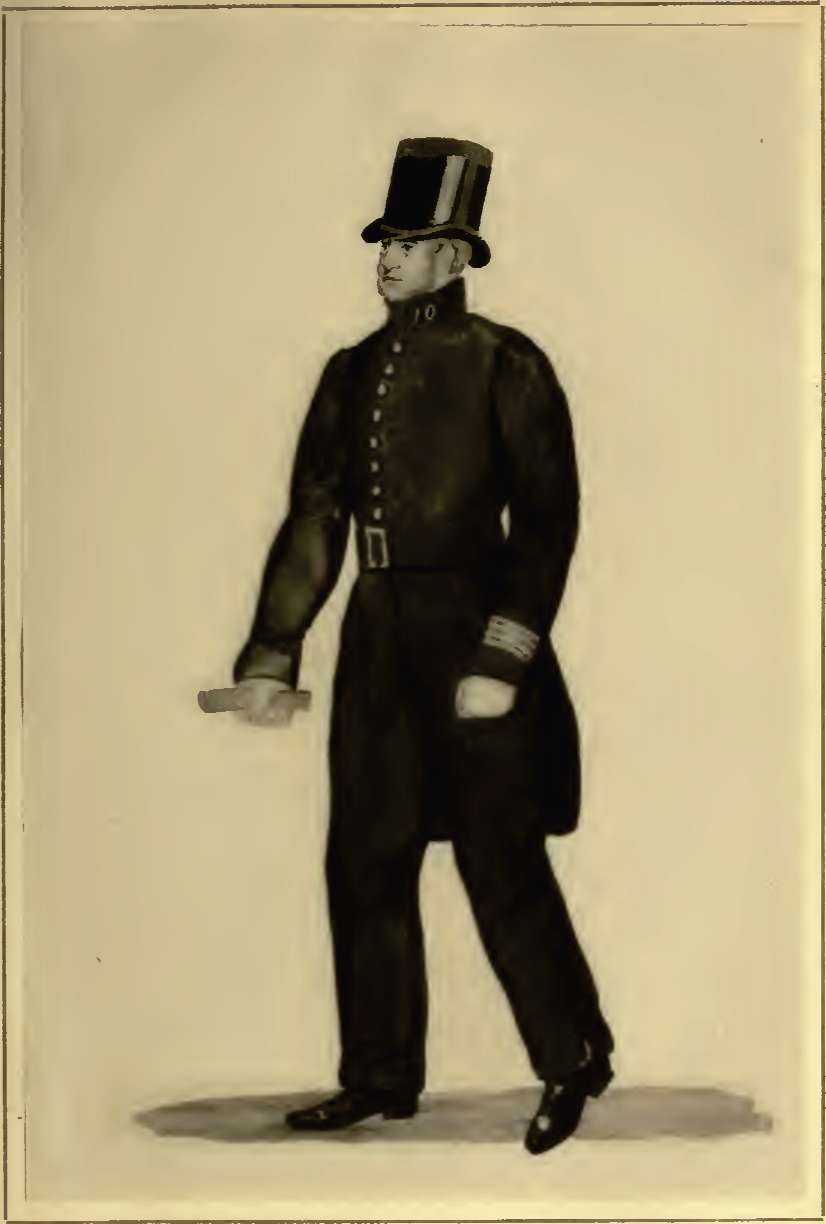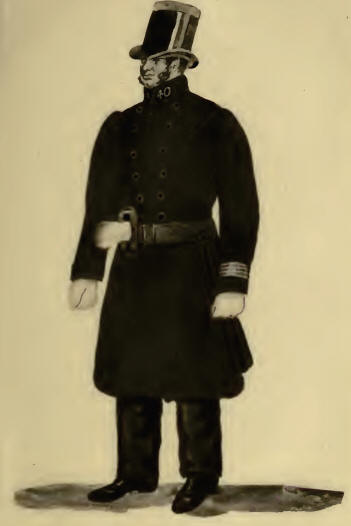|

EDINBURGH DAY POLICEMAN OF THE "FIFTIES'"
"The fashion wears out more
apparel
Than the man."
Shakespere.
1840 - 45
THE dress of the first years
of the Forties would seem strange to those, of both sexes of the twentieth
century. Looking back at the pictures which memory brings up, the whole
scene has an air of unpracticality, that seems almost inconceivably absurd
now. Ladies submitted themselves, and caused their little girls to submit,
to have their hair rolled up into small tight balls, about the size of
walnuts, and to do their best to sleep comfortably resting on these hard
knots, in order that their heads might be covered with curls in the daytime.
The older ladies wore earrings resembling inverted marks of exclamation,
hanging down as much as three inches. Old ladies often had their hair made
up into two broad flat plaits with which they covered up their ears, as if
they were ashamed of them, and above which they wore great turbans. Their
dresses I do not remember so well, except the shoulder-of-mutton sleeves,
which stuck out on both sides, and of which, though in the simplicity of
childhood I accepted them as what must be right, as my elders wore them, I
can now observe the hideousness from the pictures of that time. Girls were
treated with what seemed little short of cruelty. Some idea of prudery
ordained that their graceful little limbs should be encased in straight
up-and- down white trousers, with frills at the ankles, while their little
waists were drawn in, and their hair drawn up into hideous little knots,
tied with ribbon. Everything was done to detract from the natural grace of
the little girl—one of the very sweetest things Ľn nature.
The male sex fared no better.
I saw in my extreme childhood a few old gentlemen still dressed in top boots
and breeches, and wearing at all times coloured tailed coats with plain gilt
buttons, and the last of the judges to wear daily, wig, black breeches, and
stockings, even in the streets when he walked to and from Court, was Lord
Glenlee, who still sat on the Bench when I was born. He used, before the
building of George the IV Bridge, to plunge from Brown Square down into the
Cowgate, and climb up one of the filthy closes to the Parliament Square,
bewigged and in s^k stockings, with his court hat ;n his hand. In his
declining years he was carried daily in a sedan-chair, probably the last of
the male sex to use that old-time vehicle.
By the year 1840 the trouser
fashion had become practically universal. As a rule the gentleman's nether
limbs were encased in the tightest of pants, strapped down over boots during
the day, and over shoes at night. The tailed coat was much worn in the
daytime. It would have been an outrage for an advocate or a medical man to
wear anything else, and in their case a white tie was de rigueur. The coat
was made with the tightest of sleeves. I remember while this fashion still
obtained of being taken to hear a great statesman on his receiving the
freedom of our city, and when I saw him waving his arms, as he said to the
assemblage in pompous tones, "Long may you cherish these glamorous memories
of Old (not auld) Lang Syne," I wondered in my youthful eagerness of inquiry
how that old man managed to force those great gouty knuckles through the
pinched-m sleeves, which made his arm and hand resemble the upper part of
the drumstick of a fowl, with the flesh taken off.
A gentleman going out in the
evening always buttoned h Is coat across his chest, and with a great white
stock put twice round his neck, and held in fold by a big pin and small pin
attached together by a chain, or with a shirt front heavily beirilled with
crimped edges, he made an excellent suggestion of a pouter pigeon. Above was
long hair down to the collar of his coat, and often mutton-chop whiskers,
but never a moustache or a beard.
The tailors put an end to the
buttoning of evening coats. When 1 was quite a little fellow my father took
me out with him one day, and we went to his tailors in George Street—Messrs.
Rausch & Corpe. The make of evening coats was then changing, and. the
buttoning across in the evening was going out. On the previous night my
father had buttoned his coat across and found it very tight, and the flap on
one side sticking out most unsymmetrically. He had sent up the coat, and
suggested to Mr. Rausch that it must be altered. He put ton. "Ach," said Mr.
Rausch, "it do fit beautiful." "But," was the reply, as my father forced the
button-hole across to the button, "look at it when I button it." "Ach, ach,
but no, cried Rausch, "de coats are not now made that they be buttoned." My
father was indignant, but fashion is a hard taskmaster and he had to yield.
But though the tailed coat
was modified, so as to be only in appearance double-breasted, it was still
dominant. On all occasions, solemn or festive, it reigned supreme.
Anticipating in time a little, and as indicating how long it continued to do
so, I may mention that I witnessed the ceremony of the unveihng of Sir John
Steel's statue of the Duke of Wellington in front of the Register House, and
on that occasion several hundred gentlemen assembled in the Music Hall, and
marched to the end of Princes Street, all, according to injunctions issued,
wearing tailed coats, evening tie, tall hat, and white gloves. With the
exception of the gloves, such a procession would to-day suggest a Union of
Waiters demonstrating on strike. Then this costume ruled all society,
official and unofficial.
When I was a very few years
old I was taken to see the procession of the Lord High Commissioner to the
Church of Scotland. Being put close to one of the infantry who lined the
streets, and having a lengthy exposure made to my youthful brain camera, I
have a memograph of a man in a red-tailed coat, with white, hard cotton
epaulettes, and no end of belts and straps in pipe-clay. Above was a tall
hat, spread out at the top, very much in the shape of a kitchen mortar, with
a pompon sacking out of it, like a pestle knob. This was absurd enough,
being as unlike a fighting dress as anything could be. But the acme of
absurdity was reached when 1 saw the lie-guardsmen in London 1842 at the
Horse Guards. My nursemaid stared at them with different feelings to mine, I
doubt not. Out from below the steel cuirass came the usual tails of the
coat, made very short, and so even more ridiculous. Indeed, the clothing of
the soldier of whatever arm of the service was erninently unpractical. It is
difficult for one who did not see it even to conceive a number of
artillerymen serving guns in tailed coats. The ideas of that time as to the
dress of the soldier may be understood when the dogma ic saying of the
tailor king, George the IV, is quoted: A seam in a soldier's coat is
permissable, a crease is a crime. The only idea was stuffiness and show. As
is said by Guibert, the French military wear, showing that other nations
were as foolish as ourselves:
rNous faisons de nos soldats
des friseurs, des polisseurs, des verm'sseurs, toiUe chose Jwrmis des gens
de guerre.
Even in civil life officials
were compelled to wear coats with tails—the postman, the policeman, the
government or municipal messenger. So far was the fashion carried that the
railway signal-men, who at that time worked on foot, were seen waving their
signal-flags clothed in tight-buttoned tailed coats.

EDINBURGH NIGHT POLICEMAN OF
THE "FIFTIES"
|

